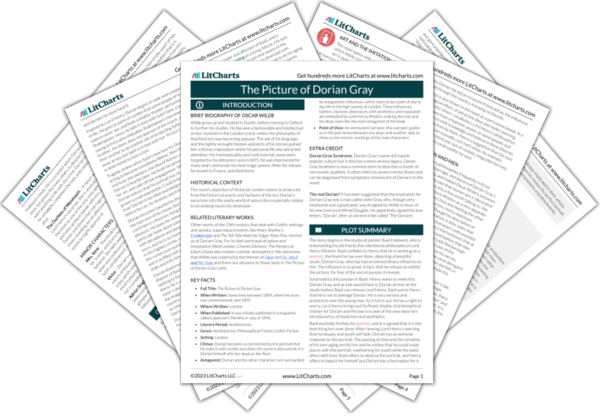Summary
Analysis
Dorian walks home. Through the streets of London, he remembers the places he has been and the awful things he has done in them. Every pleasure seems lost to him. He wonders, as he returns home, whether Henry’s words are to be believed. He wants desperately to be able to retrieve the innocent feelings of his boyhood. He deeply regrets the fateful wish he made to the portrait. How wonderful it would be now to receive each punishment for each sin in a natural form of justice.
Dorian’s thoughts have come full circle. He realizes that a life devoid of consequences, a life lived outside of time and cause and affect, leads only to monstrosity. There is no natural restraint, and in taking each small step, each one leading to the next, you lose who you originally were. He wants to life not as something eternal, but as something natural.
Themes
Quiz
Test Yourself
Dorian picks up a mirror that Henry gave him once, and remembers the words of an old lover, that the beauty of his features has rewritten history. Dorian loathes his looks now. Youth, which had once seemed so perfect, seems like his enemy. He cannot allow himself to think of the past. The threat of his crimes being discovered is over and he resolves again to start a new kind of life and perhaps if he lives well enough, the portrait will gradually return to its natural state.
The mirror shows the exact copy of the portrait when it was first painted, Dorian frozen in the peak of his beauty. Art is supposed to reflect life, but only at a moment in time. It cannot be life. With his realizations Dorian hopes he can change his ways…
Themes
Quiz
Test Yourself
Full of hope for this new possibility, Dorian rushes upstairs to the picture. As he removes the cloth, the old terror returns, full force. The figure is even uglier than before. Dorian now doubts his new resolve to do good, thinking that perhaps even these things come from vanity. As he becomes more and more distressed, he notices that red stains have grown on the painting, like blood. He considers making a confession. His own motives now seem completely unclear to him.
…but the picture is now so ugly, indicating such a rotten state of his soul that Dorian despairs. He cannot imagine how he can get back to what he was. Just as a normal man cannot regain his youth, Dorian cannot regain his innocence.
Themes
Literary Devices
Quiz
Test Yourself
In a frenzy, Dorian grabs the murder-weapon. He wants to kill the painting that has destroyed his life. As he strikes, a terrible cry is heard by his servants. The terrified servants manage to get into the room through a balcony and find their master dead on the floor, hideous and old, barely identifiable and a portrait hanging on the wall, of a beautiful young man.
Ultimately, Dorian sees the only way to eliminate the sins marring his portrait, his soul, is to destroy it. This is, once again, a selfish action, and the easy way out. The hard way would have been to fight off his despair and try do good, over and over, for decades. But Dorian instead wants to destroy his sins, and blames the portrait for his own weakness. And so he stabs his own soul, essentially, and kills himself.
Themes
Literary Devices
Quiz
Test Yourself
Get the entire The Picture of Dorian Gray LitChart as a printable PDF.













